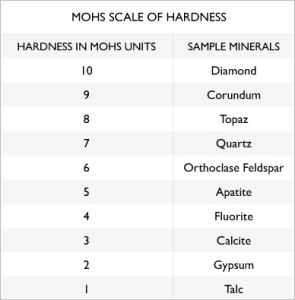To put it in very basic terms, the Mohs scale of hardness is a relative scale of “scratchability.” Basically the higher the number on the scale the harder the stone. A stone rated at an 8 can be scratched or damaged by a stone rated at a 9, but not one rated at a 7.
So all of this information is great, but how helpful is it really? What on earth is corundum? or Feldspar? These are the names given to certain groups of stones. Sapphires and Rubies are both part of the Corundum family of stones.
This scale is very helpful in determining how much abuse a gem can take. There are sometimes special exceptions, but as a general rule gemstones of a hardness of 8.0 or higher are considered to be durable. Intermediate stones are over 6.0 and up to 8.0, softer and more delicate stones are 6.0 and under. Gems that are 6.0 and under should be handled and cleaned with more care, and not exposed to chemicals or solvents.
One exception to the rule is the Emerald. Although it’s tough at 7.5 – 8.0, it should be treated with some care. There are almost no perfect Emeralds found, they have numerous inclusions (flaws), so their resistance to breaking is lower than what its hardness level would imply.
No matter how hard a stone may be on the chart, the quality of the stone also determines it’s hardness. For example a flawed diamond will be softer and more brittle than one that is absolutely perfect. The same is true for all other stones and organic gems as well.
Below are some of the most common stones and gems used in jewelry making with their hardness. As a general rule of thumb if you are putting jewelry with gemstones in a tumbler for a final polish, use caution and avoid stones below a 7 or 8 as well as any stones with visible inclusions or cracks. Generally any stones below a 7 need extra care when setting as the steel tools used to set the stones can accidentally scratch or break the stone.
Agate – 7.0 Alexandrite – 8.5 Amber* – 2.5 Amethyst – 7.0
Ametrine – 7.0 Apatite – 5.0 Aquamarine – 7.5 Aventurine – 7.0
Azurite – 3.5 Beryl – 7.5 Bloodstone – 7.0 Blue Chalcedony – 7.0
Carnelian – 7.0 Chrysoprase – 7.0 Citrine – 7.0 Coral* – 3.5
Diamond – 10.0 Emerald – 7.5 Fluorite – 4.0 Garnet – 6.5-7.5
Hematite – 6.5 Howlite – 3.5 Iolite 0 7.0 Ivory* – 2.5
Jade – 6.5-7.0 Jasper – 7.0 Jet* – 2.5 Kunzite – 7.0
Kyanite 7.0/5/0 Labradorite – 6.0 Lapiz Lazuli – 5.5 Malachite – 4.0
Moonstone – 6.0 Morganite – 7.5 Obsidian – 5.0 Onyx – 7.0
Opal – 6.0-6.5 Pearl* – 3.0 Peridot – 6.5 Rhodochrostite – 4.0
Rhodonite – 6.0 Ruby – 9.0 Sapphire – 9.0 Sardonyx – 7.0
Serpantine – 2.5-5.0 Quartz – 7.0 Sodalite – 5.5 Spectrolite – 6.0
Spinel – 8.0 Sunstone – 6.0 Tanzanite – 6.5 Tigers’s eye – 7.0
Topaz – 8.0 Tourmaline – 7.5 Turquoise (Stabalized) – 6.0
Zircon – 7.5 Cubic Zirconia – 8-8.5
Your fingernail rates at a 2.5 on the scale, a solid copper penny is a 3.5, a glass plate or pen knife is a 5.5, while a steel nail is a 6.5 and a masonry drill bit is an 8.5

